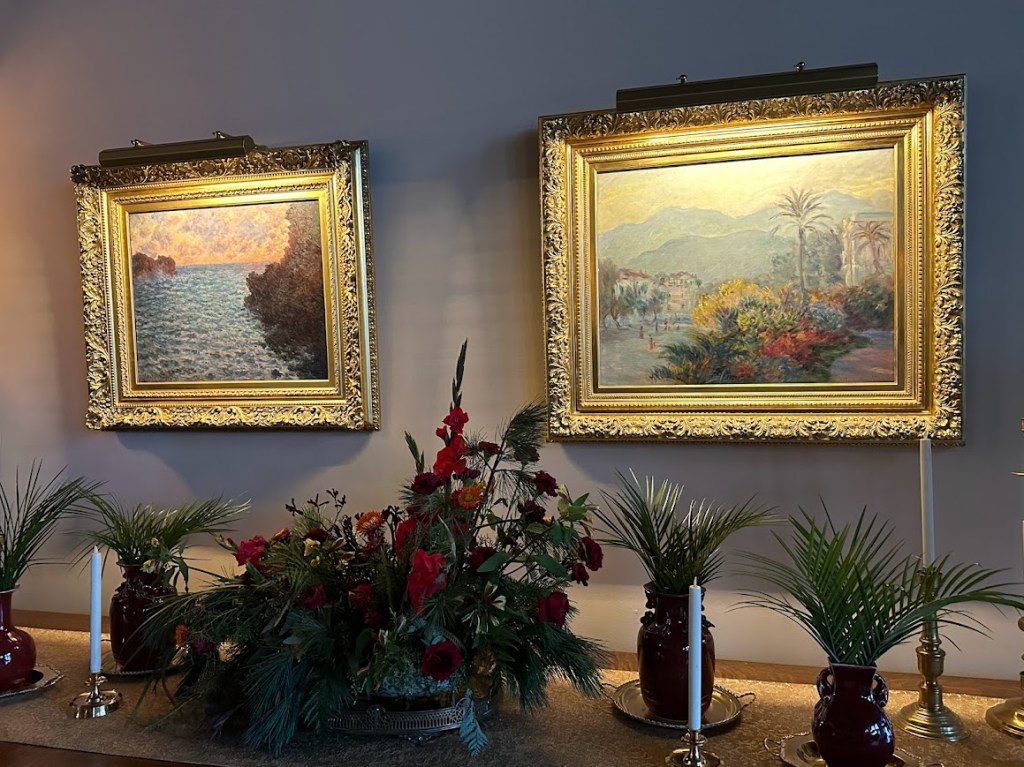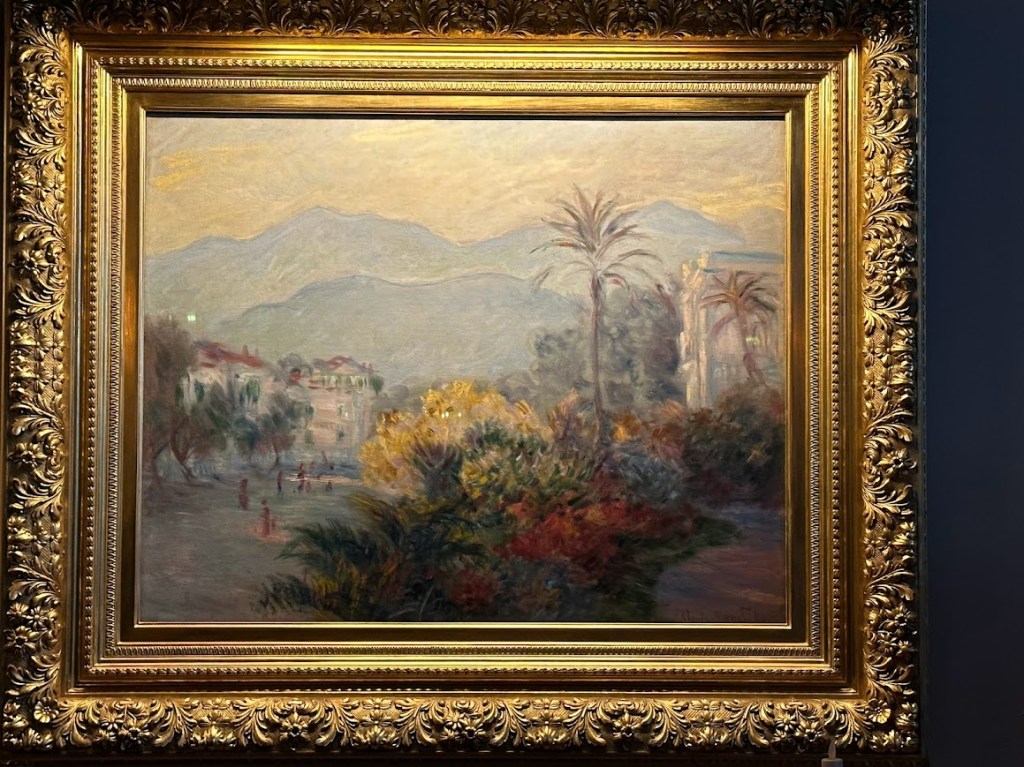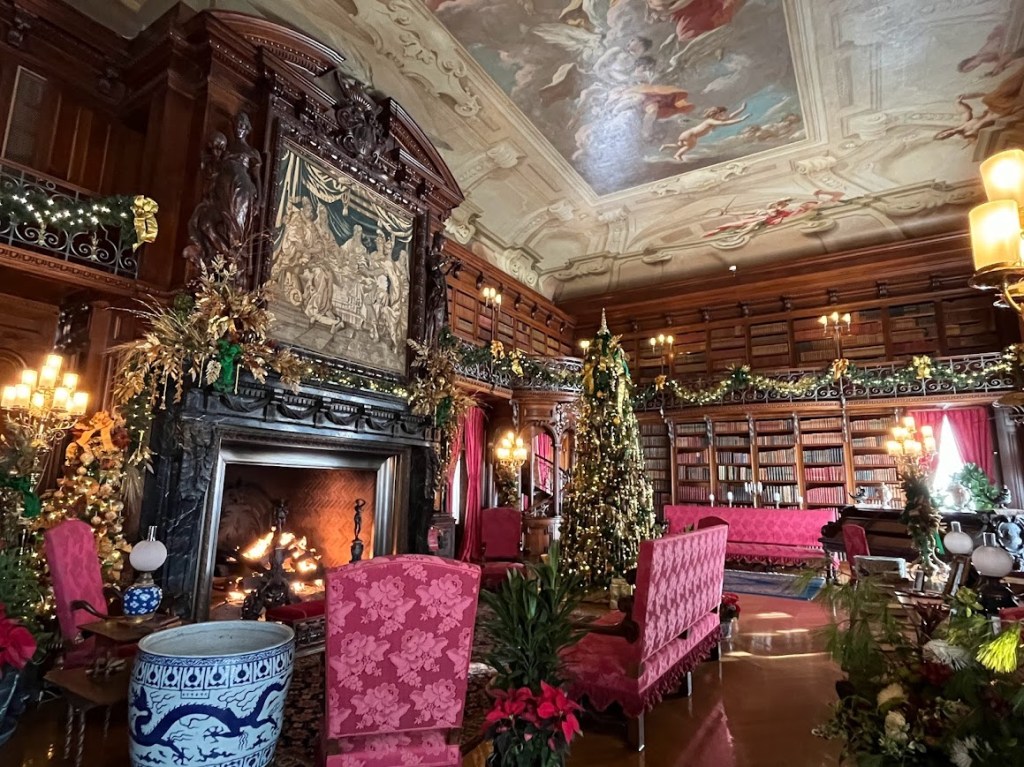
On this edition of Art Expeditions we’re traveling to Asheville North Carolina to explore the artistic wonders of the magnificent Biltmore Estate.
Cloistered by the beauty of The Blue Ridge Mountains, Biltmore is unlike any other place in America, a juxtaposition of gilded era elegance and resplendent God given beauty of the natural surroundings. George Washington Vanderbilt, grandson of Cornelius ‘Commodore’ Vanderbilt, fell in love with North Carolina’s Blue Ridge after visiting the area with his mother in 1888. He decided it would be site where he built his estate.
Biltmore is the largest home in America, a true mansion – with over 175,000 square feet. Though mansion doesn’t seem to do Biltmore justice…it isn’t just a big house – it is too inviting for that, which each room decorated perfectly for luxury and comfort…Biltmore is America’s Castle…though still owned by The Vanderbilt descendants, the home has been open to the public for decades – each visitor welcomed as a guest…it is a place I return to time and again…
George Washington Vanderbilt wanted to built not just a gilded mansion, but rather a self-sufficient working estate, where all the food would be grown at Biltmore. This would in turn provide jobs to the local Asheville community and provide the best sourced ingredients for farm to table dining. In fact when you visit Biltmore today most of the food served in the estate’s many restaurants is grown/harvested at Biltmore.
Vanderbilt enlisted the help of famed architect Richard Morris Hunt, a preeminent architect of The Gilded Age, to design his North Carolina mansion. Hunt was a frequent collaborator with The Vanderbilts, working on several of their homes including Marble House and The Breakers (Rhode Island). While G.W. Vanderbilt originally imagined a much smaller house for his estate, Hunt realized that Biltmore House needed to be grander than anyone could imagine – not out of pomp and pride, but in order to fit the landscape that surrounded it. Hunt wanted Biltmore to be sited to the land, not to overpower the mountains, but to be intertwined with them. The vision of Biltmore was an artistic one. The idea was to build a beautiful house that spared no expense for the sake of the art and landscape more than just impressing the Gilded Elite. In the end Biltmore did both.
Construction for Biltmore began in 1889…Hunt and Vanderbilt took trips to Europe to study the great architecture of cathedrals to castles as they created the design for Biltmore House. You can see evidence of the European influences of Gothic to Renaissance and Victorian Gothic and beyond in the intricate details of Biltmore House.
In addition to Hunt, famed landscape architect, Frederick Law Olmsted who designed Central Park was hired to create 75 acres of formal and informal gardens, as well as winding tree lined roads to showcase the pair the natural beauty with the architectural wonder of Biltmore House. Olmsted called Biltmore his greatest achievement.
The 175,000 square foot home is the largest in America and rivals even the great castles and edifices of Europe. It took over six years to build.
Biltmore officially opened to Vanderbilt’s friends and family on Christmas Eve, 1895. Christmas at Biltmore continues to be a time honored tradition and arguably the highlight of the year. No one does Christmas quite like Biltmore…

Biltmore is a treasure trove for art lovers:
- The house with it’s Beaux Arts Gothic Revival Style is a feast for the eyes. Every time I visit Biltmore I notice another detail, etched in the stone. The architecture is towering and yet those tiny details prevent it from feeling overwrought and daunting. It welcomes you into it’s architectural prowess.
- George Washington Vanderbilt loved art and travel and searched the world for artistic finds to bring back to Biltmore. His personal touch can be found in many of the rooms where artwork and furniture from his travels from Europe to Japan is on view
- The estate collection has over 92,000 pieces of art, including masterworks by Albrecht Durer, Renoir, Whistler, Monet and Sargent.
- What’s unique is while the art is technically on view in a house museum, it is on display as the Vanderbilt family would have kept it in Biltmore House. Can you imagine sitting down for a cup of tea and gazing up a Monet?
- Biltmore also hosts an amazing array of art and culture exhibits like Van Gogh Live and The Renaissance Immersive Experiences (Grande Experiences). They have a Chihuly Exhibit coming in April 2024
It would take all of George Washington Vanderbilt’s library to describe all the art in Biltmore House, but I wanted to share a few of my Biltmore collection favorites.

Renoir at Biltmore
Biltmore is home to two works by Pierre-Auguste Renoir…The two portraits are Young Algerian Girl and Child with an Orange, both were painted in the 1880s while Renoir traveled through the Mediterranean and Northern Africa.

These works were purchased by George Vanderbilt in 1892 from none other than famed Parisian art dealer Joseph Durand-Ruel, who is credited with doing more than just about anyone to promote the success of French Impressionists at a time when most other art critics and dealers looked down on them.
Monet at Biltmore…

In an adjacent room to the Renoir paintings you’ll discover two mesmerizing works by Renoir’s friend and fellow Impressionist Claude Monet…
*Fun fact: Pierre-Auguste Renoir and Claude Monet both studied together at the Académie Suisse.
“Monet’s work followed the textures of his subjects; the length of his brush strokes mimicked flowers and foliage, rippling water, and boats and structures. His 1872 painting Impression, Sunrise sparked the term “Impressionists” from an art critic who felt this new style had an unfinished look. The trailblazing group of artists took the name as their own, and even more interest and curiosity was sparked about the new way of creating and viewing art.” – Biltmore website

1884
I was drawn to this scene of Italy, which reminds me of another Monet work I saw from the The Joslyn Collection (Nebraska) at The Taubman (VA). I learned from that exhibit that Monet struggled to paint the palm trees in the region (he wrote his wife to lament his struggles with the trees).
“This painting and others Monet made around the same time are notable for the way in which he captures light. In this view of one of the main streets in Bordighera, a vibrant fishing village on the northwest coast of Italy, he emphasizes the brilliant colors of the striking flora.” – Biltmore guide.

Biltmore Tapestries:

At 90 feet in length, The Tapestry Gallery is the longest room in Biltmore House. It was designed to showcase part of a glorious set of tapestries known as The Triumph of the Seven Virtues.
These tapestries are 500 years old; woven from wool and silk in Flanders (Belgium) the set illustrates how the seven virtues – faith, prudence, charity, chastity, temperance, fortitude and justice would always prevail over vice.
This article from The Met details how these types of tapestries were made and the painstaking detail Flemish artisans took when weaving their tapestries
This article provides more detail on Biltmore’s tapestries
John Singer Sargent paintings at Biltmore:
Arguably the most famous portraitist of The Gilded Age, Sargent is one of my favorite painters because he is able to capture the emotion and depth of the sitter in a way you feel as though you are in the room with them. Sargent painted the who’s who of high society including The Vanderbilts. Biltmore has six Sargent paintings including his depictions of Frederick Law Olmsted (landscape architect) and architect Richard Morris Hunt.
The Olmsted portrait shows the renowned landscape architect in nature, where his vision of melding nature and architecture still resounds today.
Richard Morris Hunt is standing in Biltmore House’s glory as a ode to his genius as a visionary architect.
Unfortunately I didn’t get photos of those works, but you can see the official media here.

James Abbott McNeill Whistler

George Vanderbilt served as a patron to James Abbott McNeill Whistler, including this piece from Whistler’s Nocturne paintings. In this series, Whistler was creating a composition about colors and shapes rather than the actual subject matter – London’s Thames River at night.
Both Whistler and Sargent were master portraitists who also experimented with natural scenes and even Impressionism.
The Chariot of Aurora (circa 1720) by Giovanni Pellegrini (Italian)
On the ceiling of the George Washington Vanderbilt’s Grand Library, this gorgeous set of canvas was originally located in the ballroom of the Pisani Palace in Venice. The work comprises 13 separate canvases and measures about 64 feet long and by 32 feet wide. It depicts the mythological story of Aurora.


Napoleon’s Chess Set…
Perhaps one of the most unusual pieces in Biltmore’s collection (and mysterious) is a personal chess set used by Napoleon during his exile on St. Helena…It was given as a gift to George Washington Vanderbilt on his 21st birthday. Learn more here.
La Farge Glass can be found in the winery gift shop (Biltmore has a world class winery – enjoy a day of art capped off with a glass of wine with grapes grown on the estate…

Discover more Biltmore treasures here.
Are you ready to book your own Art Expedition to Biltmore? Click here to plan your Biltmore adventure...
Ticket prices vary by season. You can also invest in an annual pass, which I use since I’m often in Asheville.
While Biltmore offers amazing lodging options fit for a Vanderbilt and their favorite guests, it can be a bit steep if you are on a budget.
Here are a few area hotels I recommend in the vicinity that are a good value with close proximity to Biltmore:
- Baymont Inn – Biltmore Village
- Courtyard by Marriott
- Hampton Inn at Biltmore Village (there is a Hampton Inn ‘Biltmore,’ but it is in another area of town)
- Brookstone Lodge
If you want to splurge – The Grove Park Inn is my personal favorite. It is an architectural icon with its arts and crafts style…The Grove Park Inn is soaked in history from F. Scott Fitzgerald to The Pink Lady – you won’t be disappointed.
Where to eat: Biltmore has tons of great restaurants on site for any budget. My favorite haunt is Biltmore’s Stable Cafe.
Winter is a great time to visit (January-February) when the post-Christmas crowds have died down. I personally love planning a Biltmore trip during their Christmas season.
Don’t forget to subscribe for more Art Expeditions with Art Adventurer Adele Lassiter
Also check out our sister blog, American Nomad Traveler for fun travel adventures and museum tips.